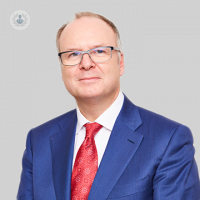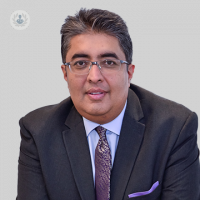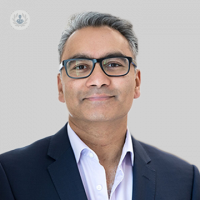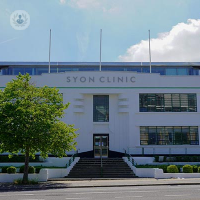What is a rhinoplasty?
A rhinoplasty, more commonly referred to as a ‘nose job’, is an operation performed to change the shape or size of the nose, whether for aesthetic or functional purposes (functional rhinoplasty).

Why is a rhinoplasty performed?
A rhinoplasty may be performed on those who are unhappy with the appearance of their nose, those who have experienced trauma to the nose, or on those who have functional problems (e.g breathing/sinus difficulties). The rhinoplasty procedure can improve the aesthetics and function of the nose, depending on the goal the patient wants to achieve.
A rhinoplasty can make the nose smaller or larger, change its shape, or change the angle that exists between the nose and the top lip.
What happens during a rhinoplasty?
Currently, two types of surgery are generally performed:
- Open rhinoplasty: A cut is made in the middle of the nose to better access the bones and cartilage.
- Closed rhinoplasty: Accessing the nose through the nostrils so no scars are left (though this operation is not always able to be done, and it depends on the skillset of the surgeon).
The operation is carried out under general anaesthetic, meaning you won’t be awake for the surgery. The procedure can take anything from one hour and a half to three hours. You may also need to stay in hospital or at the clinic overnight, or for a couple of days.
Preparation
Before the operation, you will need to attend an initial consultation with your surgeon. This may be either a facial plastic surgeon (an ENT surgeon who has trained extensively in the anatomy of the face and the functionality of the nose) or a plastic surgeon (who performs various types of plastic surgery procedures on the body). They will conduct a thorough examination, discuss your expectations with you, and determine if you are eligible for surgery.
Before your operation, if you decide to go ahead, the surgeon will take pictures in order to provide a photo analysis and discuss expected outcomes. They will also explain the risks of the surgery in detail, and ask you to sign a disclosure form.
Post-operative care
After the operation, you’ll have to take about two weeks off work in order to recover. However, results of the procedure may not be visible until a few months later. Immediately after the procedure, and after a short stay in the clinic, arrange for a friend to take you home as you will not be able to drive for a couple of days.
Your stitches can usually be removed after a week, if they are not the dissolvable kind. If you are wearing a splint, this may be able to be removed at this stage too. After three weeks, bruising and swelling should be significantly reduced. You can expect return to playing sports and higher intensity activity at about four to six weeks.
There will be some aftercare which you can follow at home with your surgeon’s recommendation, including:
- Avoiding hot baths
- Avoiding dust and smoke
- Avoiding getting your splint wet
- Making sure to sneeze through your mouth rather than through your nose
- Avoiding blowing your nose until your split is removed
- Propping your head up with pillows while resting (this helps the swelling go down)
Your doctor can prescribe you pain medication such as paracetamol to help with any pain. You may experience nosebleeds for the first few days after surgery, and there will be some swelling and bruising which will go down after time.
01-21-2016 09-19-2023Rhinoplasty (nose job)
Mr Simon Eccles - Plastic surgery
Created on: 01-21-2016
Updated on: 09-19-2023
Edited by: Carlota Pano
What is a rhinoplasty?
A rhinoplasty, more commonly referred to as a ‘nose job’, is an operation performed to change the shape or size of the nose, whether for aesthetic or functional purposes (functional rhinoplasty).

Why is a rhinoplasty performed?
A rhinoplasty may be performed on those who are unhappy with the appearance of their nose, those who have experienced trauma to the nose, or on those who have functional problems (e.g breathing/sinus difficulties). The rhinoplasty procedure can improve the aesthetics and function of the nose, depending on the goal the patient wants to achieve.
A rhinoplasty can make the nose smaller or larger, change its shape, or change the angle that exists between the nose and the top lip.
What happens during a rhinoplasty?
Currently, two types of surgery are generally performed:
- Open rhinoplasty: A cut is made in the middle of the nose to better access the bones and cartilage.
- Closed rhinoplasty: Accessing the nose through the nostrils so no scars are left (though this operation is not always able to be done, and it depends on the skillset of the surgeon).
The operation is carried out under general anaesthetic, meaning you won’t be awake for the surgery. The procedure can take anything from one hour and a half to three hours. You may also need to stay in hospital or at the clinic overnight, or for a couple of days.
Preparation
Before the operation, you will need to attend an initial consultation with your surgeon. This may be either a facial plastic surgeon (an ENT surgeon who has trained extensively in the anatomy of the face and the functionality of the nose) or a plastic surgeon (who performs various types of plastic surgery procedures on the body). They will conduct a thorough examination, discuss your expectations with you, and determine if you are eligible for surgery.
Before your operation, if you decide to go ahead, the surgeon will take pictures in order to provide a photo analysis and discuss expected outcomes. They will also explain the risks of the surgery in detail, and ask you to sign a disclosure form.
Post-operative care
After the operation, you’ll have to take about two weeks off work in order to recover. However, results of the procedure may not be visible until a few months later. Immediately after the procedure, and after a short stay in the clinic, arrange for a friend to take you home as you will not be able to drive for a couple of days.
Your stitches can usually be removed after a week, if they are not the dissolvable kind. If you are wearing a splint, this may be able to be removed at this stage too. After three weeks, bruising and swelling should be significantly reduced. You can expect return to playing sports and higher intensity activity at about four to six weeks.
There will be some aftercare which you can follow at home with your surgeon’s recommendation, including:
- Avoiding hot baths
- Avoiding dust and smoke
- Avoiding getting your splint wet
- Making sure to sneeze through your mouth rather than through your nose
- Avoiding blowing your nose until your split is removed
- Propping your head up with pillows while resting (this helps the swelling go down)
Your doctor can prescribe you pain medication such as paracetamol to help with any pain. You may experience nosebleeds for the first few days after surgery, and there will be some swelling and bruising which will go down after time.


Facelift and rhinoplasty surgery: what you need to know
By Mr Paul Tulley
2024-12-21
Cosmetic surgery can mean many things, with various procedures that could be done for a number of reasons. Facelift and rhinoplasty are both popular examples that can have an anti-ageing effect. What do they involve? Experienced plastic surgeon Mr Paul Tulley is here to explain and offer expert advice. See more


Rhinoplasty: what are the risks and what happens if I’m not satisfied with my new nose?
By Professor Charles Malata
2024-12-21
As with any cosmetic procedure, the results of a nose job are not always guaranteed. While complications are quite rare, they can still occur and it is important to be fully aware of them before choosing to undergo this procedure. In addition, a small proportion of people aren't always happy with how their nose looks after, so you should understand the steps you need to follow in case this happens to you. One of our top plastic surgeons, Professor Charles Malata explains more. See more


Can you have a rhinoplasty (nose job) if you have body dysmorphia?
By Mr Jonathan Joseph
2024-12-21
Mr Jonathan Joseph, an otolaryngologist who performs both functional and cosmetic rhinoplasty, explains how dysmorphia can be identified and dealt with so that patients get the best outcome possible. See more


What should happen in your rhinoplasty assessment
By Mr Anil Joshi
2024-12-21
It’s not every day you let a surgeon near your nose. So it’s natural to want to make sure you’re picking the very best surgeon using the latest and safest tools. What many people don’t realise is that a lot of the important work in fact happens before the procedure. We asked leading ENT and facial plastic surgeon Mr Anil Joshi what a proper pre-surgical assessment should look like to achieve the best results. See more
Experts in Rhinoplasty (nose job)
-
Professor Hesham Saleh
Otolaryngology / ENTExpert in:
- Rhinoplasty (nose job)
- Septorhinoplasty
- Endoscopic sinus surgery
- Septoplasty
- Sinusitis
- CSF Leak
-
Mr Santdeep Paun
Otolaryngology / ENTExpert in:
- Rhinoplasty (nose job)
- Septorhinoplasty
- Facelift
- Earfold®
- Nasal trauma
- Otoplasty
-
Mr Samuel Jayaraj
Otolaryngology / ENTExpert in:
- Rhinoplasty (nose job)
- Sinusitis
- Tonsillitis
- Paediatric ENT
- Endoscopic sinus surgery
- Eustachian tube dysfunction
-
Mr Simon Eccles
Plastic surgeryExpert in:
- Facelift
- Facial reconstruction
- Children's plastic surgery
- Rhinoplasty (nose job)
- Blepharoplasty
- Body contouring
-
Professor Peter Andrews
Otolaryngology / ENTExpert in:
- Rhinoplasty (nose job)
- Septorhinoplasty
- Endoscopic sinus surgery
- Nasal septal perforation
- Endoscopic skull base surgery
- Sinusitis
- See all

London Facial Plastic Surgery | Dr Julian De Silva
London Facial Plastic Surgery | Dr Julian De Silva
23 Harley St, London W1G 9QN
No existe teléfono en el centro.
By using the telephone number provided by TOP DOCTORS, you automatically agree to let us use your phone number for statistical and commercial purposes. For further information, read our Privacy Policy
Top Doctors

The London Independent Hospital - part of Circle Health Group
The London Independent Hospital - part of Circle Health Group
1 Beaumont Square, Stepney Green
No existe teléfono en el centro.
By using the telephone number provided by TOP DOCTORS, you automatically agree to let us use your phone number for statistical and commercial purposes. For further information, read our Privacy Policy
Top Doctors

Syon Clinic - part of Circle Health Group
Syon Clinic - part of Circle Health Group
941 Great West Rd, Brentford TW8 9DU
No existe teléfono en el centro.
By using the telephone number provided by TOP DOCTORS, you automatically agree to let us use your phone number for statistical and commercial purposes. For further information, read our Privacy Policy
Top Doctors
-
London Facial Plastic Surgery | Dr Julian De Silva
23 Harley St, London W1G 9QN, Central LondonExpert in:
- Blepharoplasty
- Maxillofacial Surgery
- Breast augmentation
- Plastic surgery, reconstructive and aesthetics
- Cosmetic Dermatology
- Facial aesthetics
-
The London Independent Hospital - part of Circle Health Group
1 Beaumont Square, Stepney Green, East LondonExpert in:
- Cataracts
- Bariatric Surgery
- Maxillofacial Surgery
- Neurological spinal surgery
- Orthopaedic surgery
- Orthopaedic spinal surgery
-
Syon Clinic - part of Circle Health Group
941 Great West Rd, Brentford TW8 9DU, West LondonExpert in:
- Allergies nose and ears
- Allergy Dermatitis
- Allergy
- Clinical analysis
- Anxiety
- Digestive
- See all
- Most viewed diseases, medical tests, and treatments
- Chronic headache
- Nystagmus
- Facial feminisation surgery
- Migraine
- Minimal access surgery (keyhole surgery)
- Head and neck cancer
- Neck lump
- Acellular dermal matrix (ADM)
- Prepectoral breast reconstruction
- One Stop Breast Clinic







